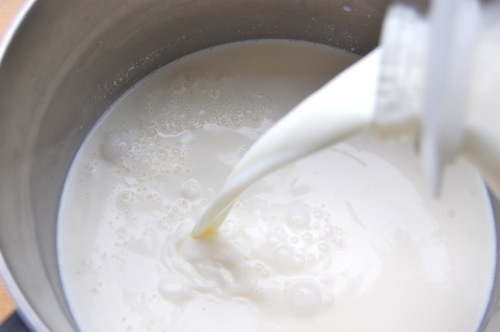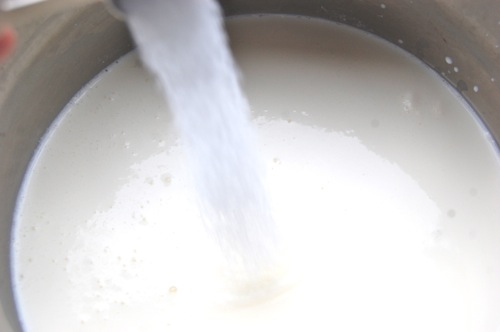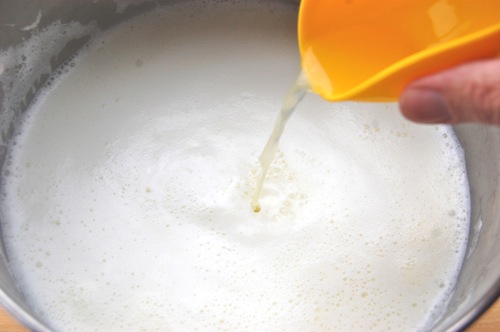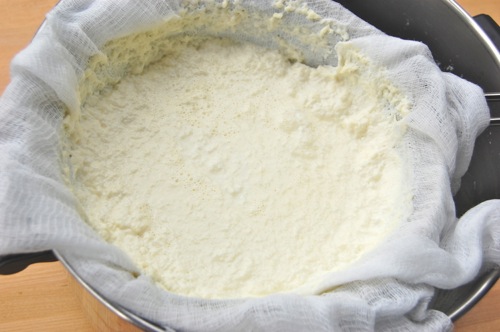Making Ricotta

Purists may cry foul because this ricotta is made with whole milk (and a little cream), but I say let them. This is the internet. They’re miles away. Classically ricotta is made from the whey left behind after provolone is made. However few if any of us can just nip down to the corner market and pick up a gallon of provolone whey, now can we? And anyway I’m on record that I believe ricotta is a process, not a fat percentage, and I’m stickin’ to it!
Yes this cheese has a little more fat than the Italian or store-bought stuff, but as I can personally attest, this is how many, many Italian-American nonninas made theirs the last century. If it’s good enough for them, it’s good enough for me. ‘Nuff said. Start by pouring your milk and cream into a large pot. The less it’s been homogenized and/or stabilized the better, since both of those processes are designed to inhibit clumping and congealing…and that’s what we’re trying to do here.

Add the salt.

Bring the whole thing to a rolling boil (it will foam quite a bit, which is why you want the big pot), then add the lemon juice.

Turn the heat down and let the pot simmer for 2-4 minutes, stirring occasionally. Meanwhile, line a strainer with cheese cloth and place it over another large pot or pan.

Don’t be under the impression that the milk mixture is going to suddenly get thick or turn into a big blob of curds or anything. All you’ll notice are some spots floating around in it. There’s really not all that much in milk that can be solidified when it gets right down to it. That’s part of the reason cream is added to the milk in this recipe, to introduce more “substance” to this mixture so the curds will be larger. Believe me, it takes a whole lot of liquid whey to make a tiny amount of ricotta.
So where was I? Oh yes, pour the whole sloppy mess into the strainer, then just let it sit.

After an hour this about where you’ll be. It’s milky and ready to eat at this point if you like…and in fact you’ll have a hard time restraining yourself once you taste it, it’s that good.

About two hours later and it’s thick enough that you can simply turn it out into a fine mesh strainer for faster draining.

If you plan on using it as a filling instead of just a snack, let it drain for several more hours. Lay some plastic wrap on the top, put the strainer and the pot into the refrigerator and let it go for at least six hours or overnight. It’s best the day it’s made but will keep for several days in the refrigerator.
Every whole milk ricotta I’ve made has separated out into curd and greenish whey. Maybe it’s just because I don’t add cream?
If you still have the whey I think you should add triple the lemon juice and try again.
To get everything I can out of whey I usually use about 200ml of white vinegar to a gallon of milk.
Your end product looks great though! Sorry. I just have never seen white whey afterward before.
Thanks Erin! Not sure why the whey would turn out greenish, but it probably does have something to do with there being leftovers in there. Protein that hasn’t been remove via rennet and probably some fat as well.
– Joe
I had always heard that whey is greenish after you precipitate most of the proteins because of the presence of riboflavin, which is sort of a yellow-green.
I think if your whey is still white then you might still have protein in it that hasn’t precipitated but it’s just a guess.
And yeah, even with the excess of acid that I use compared to you my cheese ends up pretty sweet, not as acidic as I would expect at least.
The numbers I saw for whole milk leads me to believe that you should get at least 120g of protein from a gallon of milk, plus however much fat.
Interesting. The finished product doesn’t taste too tangy afterward?
– Joe
Looks great. This is something I’ve been meaning to do for ages, I guess now’s the time. But first some questions:
Can you use a 1% or 2% milk for this (since the higher fat content is an issue)?
I’m clicking all over your blog but I can’t find the recipe. Help?
So can the liquid drained out of this ricotta be used for anything, or is the recycling on hold for a while?
Many thanks.
Hey Chana!
You certainly can use lower far milk, though your yield will be lower. Try the 2% and see what you think!
Also, some people drink whey or use it instead of water when making bread.
– Joe
Whey is absolutely perfect for a sourdough starter! The pH is much lower than tap water so the wild yeasts thrive right away.
And if you’re acidifying the whey using a culture then the bacterial component is seeded right from the beginning.
Don’t even get me started on making fermented sausages like salami using whey 🙂
I love this discussion, Joe! Your work with pastry is seriously second to none, but this stuff is my passion.
Ha! So glad to see that about making salami with whey. I use yoghurt, because that’s the source of lactic acid bacteria I always have in the house, and I’ve always been just a bit concerned that they wouldn’t quite do the trick. The salami always turns out fine, but I’ve always wondered if it wouldn’t be better with (unobtainable here) proper meat cultures. I feel vindicated.
Here’s a recipe for a 5-minute microwave version with a complete discussion of several variables such as temperature (you don’t have to bring it to a boil, just get it above 165), types of acid (buttermilk, vinegar, lemon juice), types of milk (non-UHT is better), etc. One huge advantage of this method is the ease of clean-up.
http://www.seriouseats.com/2010/02/how-to-make-fresh-ricotta-fast-easy-homemade-cheese-the-food-lab.html
Neat! Thanks Candide!
– Joe
I have been making paneer, the Indian fresh cheese, using this method for some time, although I was taught to use lime juice I don’t imagine it make a huge difference what acid you bring
I think you’re right. In my experience, unless you are using rennet, not very much acidic whey gets trapped within the curd. I use a lot more acid, I think, and my cheese doesn’t taste sour at all.
I’ll try that next time, Erin. Maybe I’ll double the lemon juice and see what happens.
Thanks!
– Joe
No, it definitely won’t make a difference. Lemon, lime, the acidity is the same. Thanks Frankly!
– Joe
Here’s Joe’s recipe: http://joepastry.com/2012/ricotta-recipe/
Would using lactose-free milk be a problem for this process? It’s my understanding that such milks contain an added enzyme…not sure if that would hinder the cheese-making at all. I’ve got some that’s about to expire, so I’ll be trying it this week unless I hear otherwise!
My feeling is that it would be OK since the congealing isn’t predicated on enzymes. However my understanding of cheese making and milk composition is rudimentary at best. I’d say try it and see what happens — then get back to us with a report!
Cheers and thanks!
– Joe
Seems to have worked quite well–the yield was a little lower than I expected (although that may have been due to the milk being skim, not whole) but I have some very tasty ricotta and a nice loaf of Italian bread made with the whey!
I think the lactose-free nature may be moot at this point because the enzymes denature somewhere around 100-120 degrees, but I needed to use up the milk anyway. Thanks, Joe!
I know this post is a year late but thanks for the story, as it’s more relevant than ever to take control of our food supply to the extent possible. Losing the ability to cook the basics- bread, cheese, etc. especially in the more socialized places that are devoid of real access to food. Funny how it’s changed so much that big cities are the place that you can’t get quality pre made food and the rural areas are now cranking out real foods like bif cities used to do! Growing up in Vermont, the parent of 2 flatlanders who came to Vermont for the quiet life gave me the yearning for real food but the landscape lacked the ingredients to produce the real deal. Now that I have tasted real ricotta, I could never use whatever that stuff in the big supermarket really is… it isn’t cheese, that’s for sure. While I can now source real ricotta locally because of the upswing in mirco farming and artisan cheesemakers there is a huge gap. Unfortunately the ‘real’ ricotta is about 8 dollars for about 2 cups of milk. This is why I am here on your page learning to make it. While you don’t give a recipe perse, I am knowledgable enough to follow along. Well, here’s hoping! I have the cheese sitting over the cheesecloth/ strainer so we shall see! I will be back though, because there are more fillings I can’t wait to make! Thanks for your service.
Best of luck with it, Melissa! Thanks very much for the comment!
– Joe